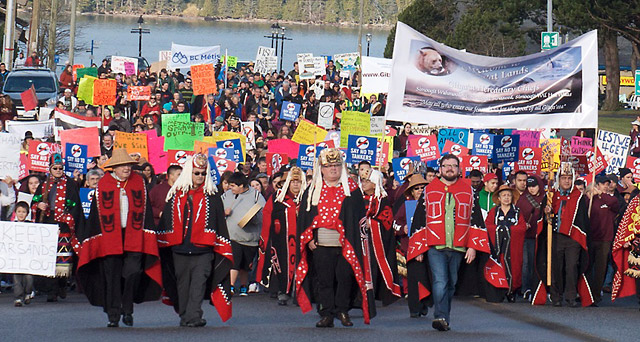|
| |
| 15. Februar 2012 |
Demonstration der Gitga’at First Nation in Prince Rupert
gegen das Northern Gateway Pipeline-Projekt |
| |
| Bereits am 4. Februar fand in Prince Rupert eine Demonstration gegen das Northern Gateway Pipeline-Projekt der Enbridge Inc. statt, zu der die Gitga’at First Nation aus Hartley Bay aufgerufen hatte. Neben den Bewohnern der kleinen Gemeinde Hartley Bay, die im Douglas Channel inmitten des Great Bear Rainforest liegt, nahmen auch viele Bürger aus Prince Rupert und Vertreter der anderen vom Pipeline-Projekt betroffenen First Nations teil, so dass die Demonstration etwa 1000 Teilnehmer zählte, die gesamte Veranstaltung in Prince Rupert über 2000. Dies ist gemessen an der sehr geringen Bevölkerungsdichte im Norden von BC und der sehr großen Distanzen, die Teilnehmer zurücklegen müssen, eine beachtlich hohe Zahl. Ian McAllister von Pacific Wild, der Autor des Buches „Tar Sands. Dirty Oil and the Future of a Continent“, Andrew Nikiforuk, der Dokumentarfilmer Damian Gillis, der Fotograf Garth Lenz, der die Umweltzerstörungen in den Teersande-Abbaugebieten Albertas zeigt, Art Sterrit von den Coastal First Nations und viele andere nahmen an der Demonstration teil. |
| |
 |
Demonstrationszug der Gitga’at und
anderer First Nations in Prince Rupert |
© Ian McAllister, Pacific Wild |
|
| |
| „Gitga’at people singing for their lives in face of Enbridge pipeline threat“, lautet der Titel des Artikels von Caitlyn Vernon von Sierra Club BC vom 10. Februar in „The Georgia Straight“: „There is strength in numbers, and strength in community. In Prince Rupert we were together with purpose, with courage and determination. There is no question that opposing these tankers is no small game, we are up against the global oil industry. But we know what would be lost in an oil spill, the jobs and wildlife and cultures and communities … The Gitga’at people live in Hartley Bay, which lies directly along the tanker route. Supertankers more than eight times larger than the Exxon Valdez would pass right in front of their village, and an oil spill would be catastrophic to their ability to harvest traditional foods from the land and ocean … These people, this community, would not survive an oil spill. Even just the presence of the tankers would have an impact, on the safety of people fishing in small boats and on ecotourism, when the whales leave because they can no longer communicate over the underwater noise of the tankers. And even just the threat of this project is having an impact. The fear, in coastal communities, is palpable. People are living with stress and uncertainty. Helen Clifton, a matriarch in Hartley Bay, once said to me that when she thinks about the tankers she feels a sense of impending doom, that she has to struggle to rise above it and fight with all she’s got.“ |
| Die nächsten Anhörungen der von Pipelinebau nach Kitimat und dem drohenden Öltankerverkehr im engen Douglas Channel Betroffenen vor dem Joint Review Panel sind am 17. und 18. Februar in Prince Rupert, am 2. und 3. März in Hartley Bay und vom 9. bis 19. März in Kitkatla. Bereits Ende Februar werden die Betroffenen auf den Queen Charlotte Islands/Haida Gwaii in Masset und Queen Charlotte City gehört werden, da auch sie bei einem drohenden Öltankerunglück vor allem auf der nördlichen Variante der Tankerroute in ihrer Existenz bedroht wären. |
| |
 |
| Demonstration in Prince Rupert |
© Sierra Shelby, The Canadian Press |
|
| |
 zurück zurück |
|
|

